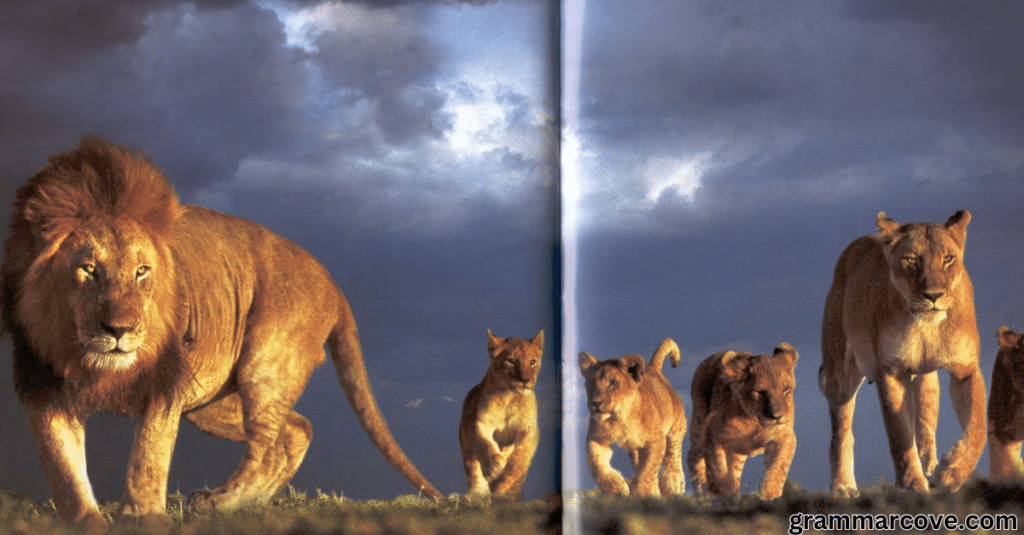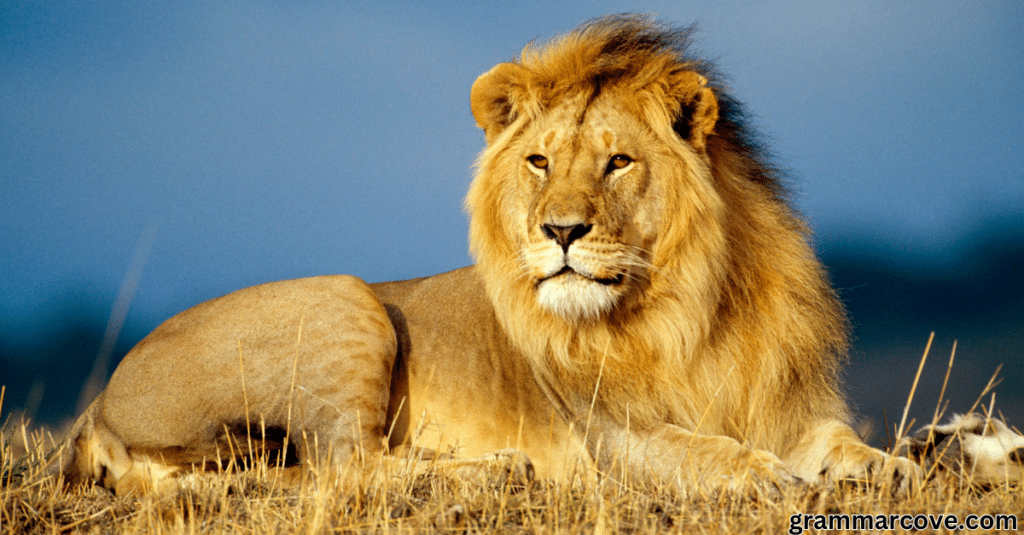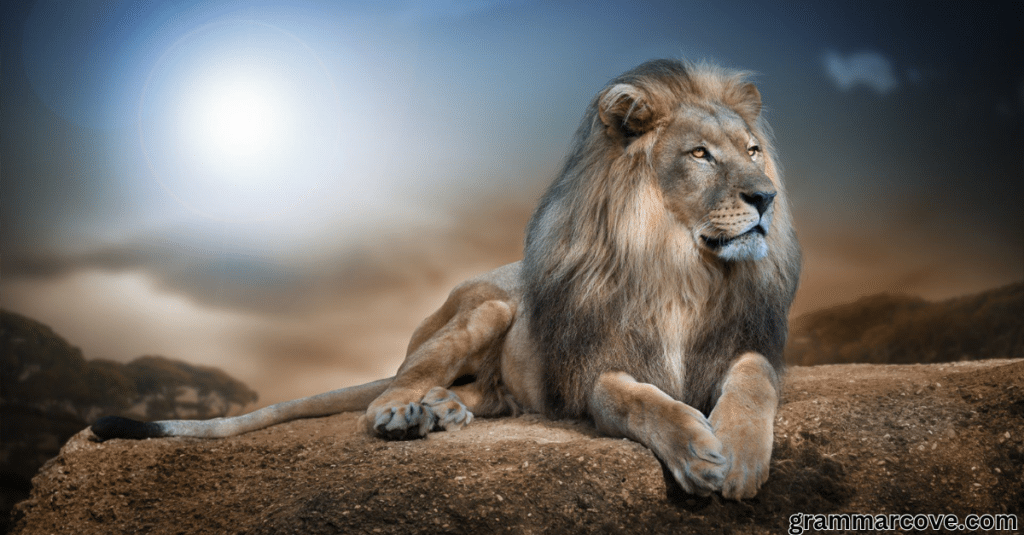When discussing the English language, few concepts are as intriguing as collective nouns. These unique terms not only capture the essence of a group but also reflect social structures and behaviors within the animal kingdom. Among the most majestic creatures, lions stand out, represented by the collective noun “pride.”
This article delves deeply into the world of collective nouns, focusing on lions, their social dynamics, and the linguistic significance of these terms, all while exploring the rich tapestry of animal behavior and symbolism.
Understanding Collective Nouns
What is a Collective Noun?
A collective noun is a word that describes a group of individuals or things. In English, collective nouns help us communicate effectively by encapsulating shared characteristics or identities within a group. They play an essential role in both everyday language and literature.
| Collective Noun | Group | Description |
|---|---|---|
| Pride | Lions | Symbolizes strength and unity |
| Murder | Crows | Evokes a sense of foreboding |
| Parliament | Owls | Suggests wisdom and deliberation |
| Pod | Whales | Implies familial bonds |
| Gaggle | Geese | Conveys chaos and noise |
| Colony | Bats | Indicates shared living spaces |
The Importance of Collective Nouns
Collective nouns enrich our language and provide insights into our perception of different species. For instance, calling a group of lions a “pride” evokes feelings of nobility and strength, while referring to a group of crows as a “murder” might instill a sense of dread. This illustrates the connection between language and perception, a concept deeply rooted in the Sapir-Whorf hypothesis, which posits that language influences thought and understanding.
The Pride of Lions

Historical Origins of “Pride”
The term “pride” in relation to lions has intriguing historical origins. It is believed to have evolved from Middle English and has roots in Old French. Historically, lions were seen as symbols of bravery and nobility, reflecting the qualities that the word “pride” embodies. The use of this term highlights the regal nature of lions and their significant role in various cultures.
The Social Structure of Lions
Lions exhibit a matriarchal society where females typically do the majority of hunting and caring for the young. A pride generally consists of related females, their cubs, and a few dominant males. This hierarchical structure is essential for understanding lion behavior and their communal approach to hunting and territory.
Example: Email Discussion
Subject: The Fascinating World of Lions
To: Sarah Johnson
From: James Miller
Hi Sarah,
I recently read about the social structure of lions and found it fascinating how they operate within a pride. Did you know that females do most of the hunting while the males defend their territory? It’s such a matriarchal society!
I also learned about the term’s origins, which trace back to Middle English and Old French. It’s interesting how language shapes our understanding of these animals. The term “pride” really embodies their strength and unity as a group.
Looking forward to discussing this more!
Best,
James
The Symbolism of Lions

Lions as Symbols of Strength and Unity
Lions are often depicted as symbols of strength, courage, and royalty across various cultures. The collective noun “pride” adds a layer of meaning, emphasizing not just their social bonds but also their noble qualities. In heraldry, lions frequently appear on coats of arms, representing bravery and valiance.
Example: School Project Presentation
Title: The Symbolism of Lions in Different Cultures
Presented by: Emma Thompson
Grade: 10
Introduction:
Lions have always held a special place in human culture. Their collective noun, “pride,” reflects their social bonds and can symbolize the unity of a community.
Body:
Across cultures, lions are seen as strength and courage. For instance, in Ancient Egypt, they were associated with the goddess Sekhmet, symbolizing war and protection. The symbolism of lions extends beyond their physical attributes; it resonates with values such as loyalty and power.
Conclusion:
Understanding the term “pride” offers insight into not only the animal behavior of lions but also the human perception of these majestic creatures.
Comparative Analysis of Collective Nouns
Collective Nouns: A Poetic Exploration
The English language is rich with collective nouns that evoke vivid imagery and emotions. Here are some comparisons that highlight this linguistic diversity:
| Collective Noun | Animal | Description |
|---|---|---|
| Pride | Lions | Evokes nobility and community |
| Murder | Crows | Suggests foreboding and darkness |
| Parliament | Owls | Implies wisdom and deliberation |
| Pod | Whales | Indicates a family bond |
| Gaggle | Geese | Conveys noise and chaos |
| Colony | Bats | Reflects shared living spaces |
The Importance of Collective Nouns
The varying collective nouns not only provide an aesthetic quality to language but also shape how we perceive the animals they describe. The collective noun “pride” for lions emphasizes their unity and strength, while the “murder” of crows carries a more ominous tone. This demonstrates how the language we use can influence our feelings and thoughts about the natural world.
Example: Blog Post
Title: Collective Nouns: Language and Animal Behavior
When we refer to a “pride of lions,” we evoke images of strength and unity. In contrast, calling a group of crows a “murder” presents a starkly different picture. This disparity highlights how language and perception are intertwined.
For instance, the collective noun for whales, “pod,” suggests nurturing behavior and familial ties, while the “gaggle” of geese hints at the lively chaos of their gatherings. Understanding these terms can deepen our appreciation for wildlife terminology and the behaviors they signify.
Linguistic Insights and Animal Behavior
The Role of Language in Understanding Animal Groups
The terminology we use to describe groups of animals reflects broader societal norms and behaviors. The unique group terminology employed for different species illustrates the rich interplay between language and animal behavior.
Example: Social Media Discussion
Post: Exploring Collective Nouns
User: Mark Adams
I’ve been fascinated by the different collective nouns for animals! Did you know that a group of lions is called a “pride”? This really emphasizes their social structure and the bonds they share. On the other hand, a “murder” of crows has a much darker connotation.
What are your favorite collective nouns, and what do you think they say about the animals they describe?
Wildlife and Human Connection
Understanding animal behavior through collective nouns helps bridge the gap between humans and the natural world. By recognizing the nuances in language, we become more attuned to the lives of these creatures. The terminology reflects our views, cultural significance, and the behaviors that define different species.
The Complexity of Animal Behavior in Prides
Social Dynamics within a Pride
Within a pride, relationships are complex and dynamic. Female lions usually form strong bonds, helping each other raise their cubs and supporting one another in hunts. Males, while more solitary, must defend their territory to maintain their status within the pride.
Example: Educational Presentation
Title: The Social Dynamics of Lion Prides
Presented by: David Lee
Audience: Wildlife Conservation Club
Introduction:
Today, I will discuss the fascinating social dynamics of lion prides.
Body:
The females in a pride often work together, showcasing a strong matriarchal society. Their cooperation is vital for hunting and protecting the young. Males, meanwhile, must be vigilant in defending their territory from intruders.
Conclusion:
Understanding these dynamics is crucial for wildlife conservation efforts. By appreciating the strength and unity of lion prides, we can better advocate for their protection.
The Role of Collective Nouns in Conservation
Linguistics and Conservation
Language plays a crucial role in wildlife conservation efforts. The use of collective nouns can influence public perception and awareness. For instance, referring to a group of lions as a “pride” emphasizes their social nature and the need to protect their communities.
Example: Awareness Campaign
Campaign Title: Protecting the Pride
Organized by: Wildlife Conservation Society
Objective:
To raise awareness about the importance of protecting lion prides in the wild.
Strategies:
- Educational Workshops: Host workshops in schools to teach students about the social structures of lions and the significance of their collective noun.
- Social Media Campaign: Use platforms to share facts about lion prides and their social behavior, encouraging discussions on wildlife conservation.
- Community Engagement: Organize community events that allow people to observe lions in their natural habitats, fostering a deeper connection with these animals.
Conclusion:
By emphasizing the concept of “pride,” we can cultivate a greater appreciation for lions and motivate individuals to take action for their conservation.
The Cultural Impact of Lions

Lions in Art and Literature
Throughout history, lions have been represented in art, literature, and mythology, often symbolizing courage, nobility, and strength. The collective noun “pride” serves as a powerful reminder of these traits.
Example: Literature Review
Title: The Symbolism of Lions in Literature
Author: Sophia Martinez
Abstract:
This paper explores the representation of lions in literature, focusing on how the term “pride” has influenced our understanding of these animals.
Body:
Lions appear in various literary works, often embodying themes of bravery and leadership. From Aesop’s fables to modern novels, the symbolism of lions as “pride” connects to their social behavior and role as protectors of their communities.
Conclusion:
The collective noun “pride” not only shapes our understanding of lions but also enriches literary narratives, emphasizing the qualities we admire in these majestic creatures.
The Symbolism of the Lion’s Pride
Cultural Significance Across the Globe
Lions have held significant symbolic value in various cultures, often representing power, leadership, and guardianship. The term “pride” reflects these qualities, suggesting a strong community bond.
| Culture | Symbolism of Lions |
|---|---|
| Ancient Egypt | Symbol of protection and war (Sekhmet) |
| Heraldry | Representation of courage and nobility |
| Christianity | Symbol of Christ and divine protection |
| Asian Cultures | Representing strength and guardianship |
Example: Cultural Presentation
Title: Lions in World Cultures
Presented by: Ryan Chen
Audience: Cultural Studies Class
Introduction:
Lions are more than just animals; they hold deep symbolic meanings in various cultures.
Body:
In Ancient Egypt, lions symbolized protection, while in heraldry, they represented bravery and nobility. The term “pride” encapsulates these attributes, emphasizing the strength and unity within lion communities.
Conclusion:
Understanding the cultural significance of lions enhances our appreciation for these animals and their role in human history.
The Role of Collective Nouns in Education
Teaching Collective Nouns
Educators can use collective nouns to enhance vocabulary and understanding of animal behavior in students. Incorporating discussions about lions and their collective noun can spark interest in wildlife conservation and linguistics.
Example: Classroom Activity
Activity Title: Discovering Collective Nouns
Objective:
To teach students about collective nouns through interactive activities.
Instructions:
- Group Discussion: Students will share collective nouns they know, discussing their meanings and implications.
- Research Project: Assign each student to research a specific animal and present its collective noun, exploring the behaviors that define its social structure.
- Creative Writing: Encourage students to write a short story featuring their chosen animal and its collective noun, emphasizing the traits associated with the group.
Conclusion:
By exploring collective nouns, students will develop a deeper understanding of language, animal behavior, and the importance of wildlife conservation.
Conclusion: The Richness of Collective Nouns
The collective noun “pride” for lions encapsulates a wealth of meaning, reflecting their social bonds, hierarchical structures, and cultural symbolism. As we explore the linguistic richness surrounding animal groups, we gain a deeper understanding of both animal behavior and our connection to the natural world.
Language not only helps us communicate but also shapes our perception of the wildlife around us. By examining collective nouns, we appreciate the beauty of diversity in wildlife terminology and the intricacies of social structures within the animal kingdom.
As you encounter different collective nouns, take a moment to reflect on the stories they tell and the lessons they impart about unity, strength, and the interconnectedness of life. The term “pride” serves as a powerful reminder of the strength that comes from community, urging us to advocate for the protection of lions and their habitats.


